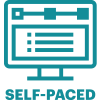Format: Self-paced Course 
Developed by: WebJunction, in collaboration with Project for Public Spaces (PPS)
Length: includes 1.5 hours of recorded instruction, plus 5-6 hours of reading and assignments; the community discovery process is open-ended but plan on 1-2 months to make meaningful use of the community engagement tools.
Overview: introduces the concepts of active learning and placemaking, and the tools and process for community discovery
By the end of this course, you will be able to:
- Recognize the shift in the library’s role in its community
- Define the key characteristics of active learning in a library setting
- Recognize effective strategies for authentic community discovery of community needs and interests
- Use community data sources to describe community and identify target audiences of discovery
- Utilize appropriate tools, methodologies, strategies to conduct community discovery activities related specifically to active learning opportunities at the library
- Recognize the value and potential contributions from partners and volunteers
Lead Course Developer: Betha Gutsche
Format: Self-paced Course
Developed by: WebJunction, in collaboration with Shannon Barniskis, University of Wisconsin - Milwaukee, School of Information Studies, and Lauren Stara, Library Building Specialist, Massachusetts Board of Library Commissioners
Length: includes 3 hours of recorded instruction, plus 5-6 hours of reading and assignments
Overview: builds on the results of the community discovery process, adapting design thinking approaches to arrive at an actionable idea and a space ready for transformation
By the end of this course, you will be able to:
- Re-envision the use of library space and the characteristics of engaging space in a manner that supports community active learning priorities
- Designate and clear a space in the library to prepare for transformation
- Understand the principles and general process of human-centered design and design thinking
- Synthesize community input to identify patterns and priority needs for use of library space
- Apply techniques of ideation and prototyping to develop actionable ideas
Lead Course Developer: Betha Gutsche
Format: Self-paced Course
Developed by: WebJunction
Length: includes 1 hour total of recorded instruction, plus 3-4 hours of reading and assignments; the actual implementation time is dependent on many factors, including the scope of the project, level of support from staff, community members and funders, and unpredictable things like weather and infrastructure.
Overview: takes the planning through the steps of making the space and service transformation happen
By the end of this course, you will be able to:
- Clarify goals, purpose and intended outcomes
- Formulate a project plan and manage implementation
- Effectively enlist the support of partners, community members and volunteers
- Activate the space with people and programming
Lead Course Developer: Betha Gutsche

